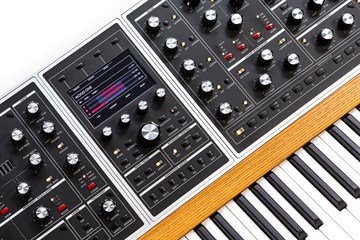Voice Modeling with Moog One
Exploring Voice Component Modeling on the Moog One
 The Moog One is capable of doing some voice component modeling in order to replicate vinatage poly synth character, and improve modeling of acoustic ensemble type of patches. Voice modeling creates small offsets to oscillator tuning, envelope timings and other characteristics, on a per voice basis, to replicate the type of character that older vintage poly synths have.
The Moog One is capable of doing some voice component modeling in order to replicate vinatage poly synth character, and improve modeling of acoustic ensemble type of patches. Voice modeling creates small offsets to oscillator tuning, envelope timings and other characteristics, on a per voice basis, to replicate the type of character that older vintage poly synths have.
To setup voice modeling on the Moog One, you'll want to use the Random Keyed Mod Source, routed to Osc Frequency. You can set up three mod slots, using Random Keyed 1, Random Keyed 2, and Random Keyed 3 sources, and routing them to Osc 1, Osc 2 and Osc 3 frequency. Experiment with the modulation values to get a small amount of detuning Per Oscillator, Per Voice. Try keeping the values low - you don't need a lot of oscillator tuning variance to get a lot of natural phasing.
You can also setup three Constant sources routed to Osc 1, Osc 2 and Osc 3 frequency, with a negative value at 1/2 the amount you set for the Random Keyed mod slots. This will effectively offset the Oscillator tunings halfway back, to turn the unipolar Random amount into a Bipolar random amount, centered on the nominal frequency.
Next, try setting up another mod slot with the Random Keyed 1 source, routed to Filter (and/or) Amp Attack, Decay or Release. This will offset the ADR timings from voice to voice to replicate the looser character of vintage synths. This effect is particularly noticable when playing stacks or unison patches where multiple notes are triggered and released simultaneously. Try to create a Tom Sawyer type of resonant filter sweep with this technique, and enjoy the lush staggered resonant sweep sound.
Tim Shoebridge has uploaded a video showing this type of voice modeling on the Moog One, using a slightly different technique with a Mod Transform Sin Function to accomplish Bi-Polar voice modeling modulation to oscillator tunings. Check out Tim's great video here: